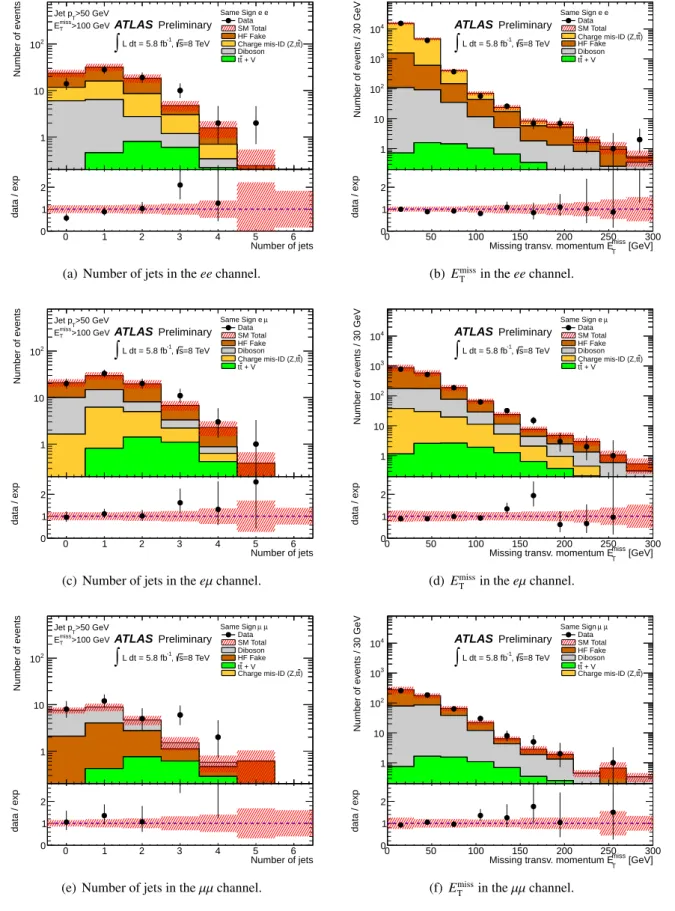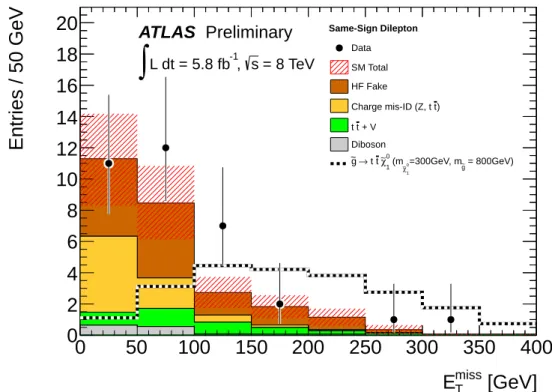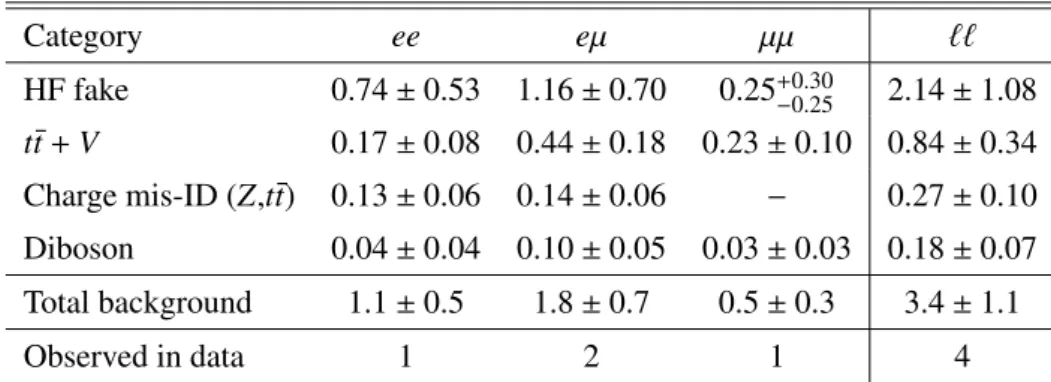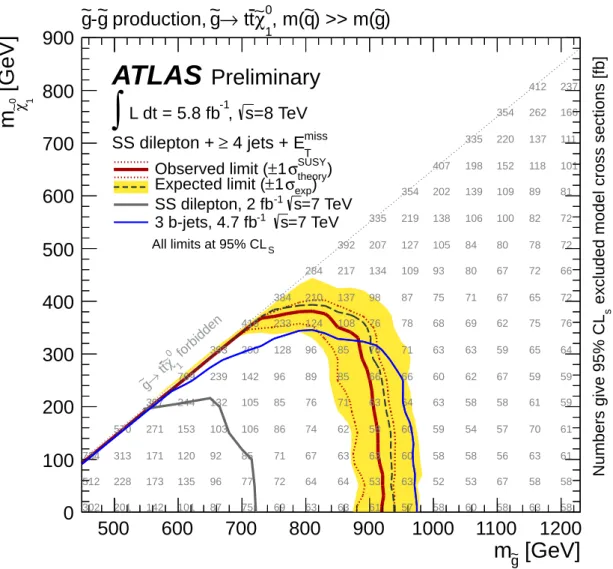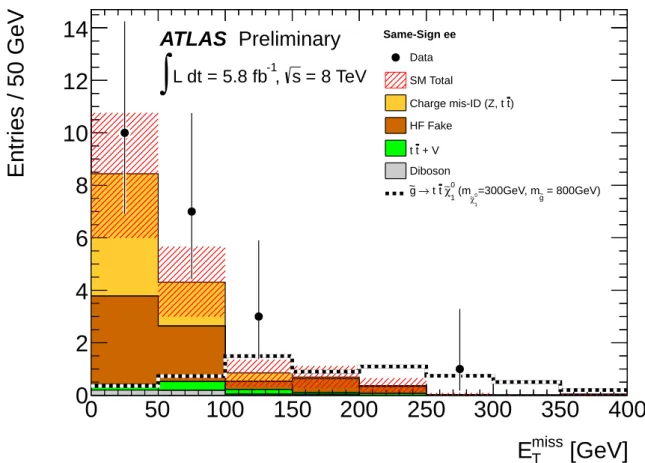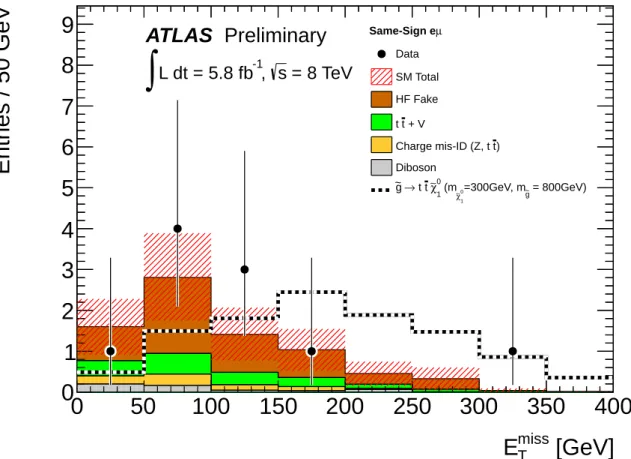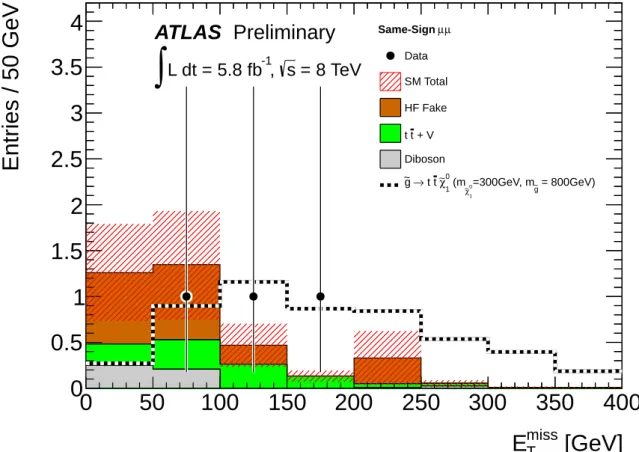ATLAS-CONF-2012-105 13August2012
ATLAS NOTE
ATLAS-CONF-2012-105
August 8, 2012
Search for Supersymmetry in final states with two same-sign leptons, jets and missing transverse momentum with the ATLAS detector in pp
collisions at √
s = 8 TeV
The ATLAS Collaboration
Abstract
A search for the production of supersymmetric particles decaying into final states with jets, missing transverse momentum and two isolated leptons, e or µ, of the same sign is presented. The analysis uses a data sample collected during the first half of 2012 that corre- sponds to a total integrated luminosity of 5.8 fb
−1of √
s = 8 TeV proton-proton collisions recorded with the ATLAS detector at the Large Hadron Collider. No deviation from the Standard Model expectation is observed. Exclusion limits are derived in simplified models in Supersymmetry where the gluino decays via a top squark into t¯ t χ ˜
01. In those models, gluino masses below 800 − 890 GeV are excluded for neutralino masses up to 360 GeV. In the MSUGRA/CMSSM framework with tan β = 10, A
0= 0 and µ > 0, m
1/2values are excluded below 270 − 420 GeV for m
0values up to 3 TeV.
c
Copyright 2012 CERN for the benefit of the ATLAS Collaboration.
Reproduction of this article or parts of it is allowed as specified in the CC-BY-3.0 license.
1 Introduction
Supersymmetry (SUSY) [1–9] predicts new bosonic partners for the fermions and fermionic partners for the bosons in the Standard Model (SM). In R-parity conserving SUSY models [10–14], the lightest supersymmetric particle (LSP) is stable and weakly interacting, and SUSY particles are pair-produced in proton-proton collisions. The LSP escapes detection, giving rise to events with significant missing trans- verse momentum ( p
Tmissand its magnitude E
Tmiss). The dominant production channels for SUSY particles at the LHC are squark-(anti)squark, squark-gluino and gluino pair production, if on-shell squarks and gluinos can be produced with the available beam energies.
In SUSY models, the gluino is a strongly-interacting Majorana fermion. Several SUSY scenarios predict that one of the supersymmetric partners of the top quark (˜ t
1) and the anti-top quark (˜ t
1∗) are lighter than the other squarks [15, 16]. Therefore top quarks and (virtual) ˜ t
1squarks can be produced copiously in gluino decays via ˜ g˜ g → t¯ t t ˜
1t ˜
∗1, tt t ˜
∗1t ˜
∗1, t¯ ¯ t t ˜
1t ˜
1[17–21]. The ˜ t
1squark can further decay to the lightest chargino ( ˜ χ
±1) or lightest neutralino ( ˜ χ
01) via ˜ t
1→ b χ ˜
±1or ˜ t
1→ t χ ˜
01producing isolated leptons and jets in the top quark or chargino decay. A signature for such processes are therefore events with isolated leptons, jets and missing transverse momentum from the undetected neutralinos. Pair-produced gluinos have equal probability to produce in their decays a pair of leptons with the same charge (same-sign, SS) and opposite charge (opposite-sign, OS).
This analysis considers events with pairs of isolated same-sign leptons `` (ee, eµ, µµ), multiple high- p
Tjets and large E
Tmiss. The requirement of SS leptons utilizes the Majorana nature of the gluino and suppresses the contribution from SM processes and thus enhances the potential SUSY signal significance.
The main background arises from Standard Model processes (mainly t¯ t) with one isolated lepton and another reconstructed lepton from heavy flavor decays (HF fakes). Smaller background contributions are expected from t¯ t + W/Z, isolated lepton pairs where the sign of one lepton charge is wrongly reconstructed (charge mis-ID, mainly from Z / γ
∗, t¯ t) and real SS dilepton events from WZ and ZZ processes (diboson).
This note presents a search for SUSY in events with SS dileptons at √
s = 8 TeV. Previous results have been published by ATLAS at √
s = 7 TeV [22] and CMS at √
s = 7 TeV [23] and 8 TeV [24].
2 ATLAS detector and event reconstruction
The ATLAS detector [25] features tracking detectors surrounded by a 2 T superconducting solenoid, calorimeters, and a muon spectrometer in a toroidal magnetic field. The calorimeters, with acceptance covering the pseudorapidity range |η| < 4.9, are composed of high-granularity liquid-argon calorimeters with lead, copper, or tungsten absorbers and an iron scintillator calorimeter.
Jets are reconstructed from three-dimensional calorimeter energy clusters by using the anti-k
talgo- rithm [26,27] with a radius parameter of 0.4. Jet energies are corrected [28] for detector inhomogeneities, the non-compensating nature of the calorimeter, and the impact of multiple overlapping pp interactions, using factors derived from test beam, cosmic ray, pp collision data and from a detailed Geant4 [29]
detector simulation [30]. Jets are required to have p
T> 20 GeV and |η| < 2.8.
Electron candidates must satisfy the “tight” selection criteria as defined in Ref. [31] and are required to fullfill p
T> 20 GeV, |η| < 2.47 and to be isolated, i.e. the scalar sum of p
Tof charged tracks, Σ p
T, within a cone in the η − φ plane of radius ∆ R = 0.2 around the candidate excluding its own track must be less than 10% of the electron p
T. They must have longitudinal and transverse impact parameters within 2 mm and 1 mm, respectively, of the primary vertex. Muon candidates are required to have p
T> 20 GeV,
|η| < 2.4 and are identified by matching an extrapolated inner detector track and one or more track segments in the muon spectrometer [32, 33]. In addition, muons are required to have longitudinal and transverse impact parameters within 1 mm and 0.2 mm, respectively, of the primary vertex and to be isolated, i.e. Σ p
T< 1.8 GeV for a cone with ∆ R = 0.2.
1
The calculation of E
Tmiss[34] is based on the vectorial sum of the p
Tof reconstructed jets (with p
T>
20 GeV and |η| < 4.5) and leptons as well as calorimeter energy clusters not belonging to reconstructed objects.
3 Monte Carlo Simulation
Simulated Monte Carlo events are used to model the SUSY signal efficiency, to optimize the event selection requirements and to aid in the description of the Standard Model backgrounds. Top-quark pair and single-top production are simulated with MC@NLO [35], fixing the top-quark mass at 172.5GeV, and using the next-to-leading-order (NLO) parton density function (PDF) set CT10 [36]. Samples of W +jets and Z +jets with both light- and heavy-flavor jets are generated with ALPGEN [37] and PDF set CTEQ6L1 [38]. The fragmentation and hadronization for the ALPGEN and MC@NLO samples are performed with HERWIG [39], using JIMMY [40] for the underlying event. Samples of t¯ t W( + jets) and t¯ t Z (+jets), referred to as t¯ t + V , are generated with MADGRAPH [41] interfaced to PYTHIA [42]. The total LO cross sections for these samples are 0.197 pb and 0.155 pb, respectively. They are normalized to NLO using K-factors of 1.2 and 1.3 for t¯ t W and t¯ t Z, respectively [43–45]. Diboson samples are generated with SHERPA and PDF set CT10 for WW , WZ and ZZ processes and normalized to NLO cross sections with K-factors of 1.07, 1.06 and 1.11, respectively [46, 47]. SUSY signal processes are simulated using HERWIG ++ . The MSUGRA / CMSSM [48–53] particle spectrum is calculated with SOFTSUSY [54] using tan β = 10, A
0= 0 and µ > 0. The SUSY sample yields are normalized to the results of next-to-leading order calculations in α
s, including the resummation of soft gluon emission at next-to-leading-logarithmic accuracy (NLO + NLL) [55–59].
The nominal cross sections and the uncertainties are taken from an envelope of cross section pre- dictions using di ff erent PDF sets and factorization and renormalization scales, as described in Ref. [60].
This results in theoretical uncertainties of 30% and 50% for the t¯ tW and t¯ tZ and 10% for t¯ t cross sections, respectively. The theoretical uncertainties of SUSY signal processes depend on the parameter choices;
they are typically around 25%.
MC samples are processed through a detector simulation [30] based on Geant4 [29] and reconstructed in the same manner as the data. The simulation includes the effect of multiple pp collisions and is weighted to reproduce the observed distribution of the average number of collisions per bunch crossing.
4 Event selection and background
The data set corresponds to a total integrated luminosity of 5.8 fb
−1with a relative uncertainty of 3.6%
of proton proton collision data at √
s = 8 TeV taken in the first half of 2012. This data set is selected by a three-level trigger system. The signal region selection is based on an E
missTtrigger, which provides an efficiency in excess of 97% for E
missT> 150 GeV. For background and validation studies, dilepton triggers are used to define a control sample with E
missT< 150 GeV.
Events in which the two highest p
Telectrons or muons with p
T> 20 GeV have the same electric
charge are preselected. In addition, at least four jets with p
T> 50 GeV are required. The lepton and high
p
Tjet requirements lead to a reduced sensitivity to pile-up e ff ects. On top of these baseline requirements
the signal region is defined by E
missT> 150 GeV. The requirement for the signal region was optimized
with various models of gluino decays with isolated same-sign leptons in the final state [22].
0 1 2 3 4 5 6
Number of events
1 10 102
Same Sign e e Data SM Total HF Fake
) t Charge mis-ID (Z,t Diboson
+ V t t
ATLASPreliminary
=8 TeV s
-1, L dt = 5.8 fb
∫
>50 GeV Jet pT
>100 GeV
miss
ET
Number of jets
0 1 2 3 4 5 6
data / exp
0 1 2
(a) Number of jets in theeechannel.
[GeV]
miss
Missing transv. momentum ET
0 50 100 150 200 250 300
Number of events / 30 GeV
1 10 102
103
104
Same Sign e e Data SM Total
) t Charge mis-ID (Z,t HF Fake Diboson + V t t
ATLASPreliminary
=8 TeV s
-1, L dt = 5.8 fb
∫
[GeV]
miss
Missing transv. momentum ET
0 50 100 150 200 250 300
data / exp
0 1 2
(b) ETmissin theeechannel.
>100 GeV
miss
Number of jets with pT>50 GeV && ET
0 1 2 3 4 5 6
Number of events
1 10 102
µ Same Sign e
Data SM Total HF Fake Diboson
) t Charge mis-ID (Z,t
+ V t t
ATLASPreliminary
=8 TeV s
-1, L dt = 5.8 fb
∫
>50 GeV Jet pT
>100 GeV
miss
ET
Number of jets
0 1 2 3 4 5 6
data / exp
0 1 2
(c) Number of jets in theeµchannel.
[GeV]
miss
Missing transv. momentum ET
0 50 100 150 200 250 300
Number of events / 30 GeV
1 10 102
103
104
µ Same Sign e
Data SM Total HF Fake Diboson
) t Charge mis-ID (Z,t
+ V t t
ATLASPreliminary
=8 TeV s
-1, L dt = 5.8 fb
∫
[GeV]
miss
Missing transv. momentum ET
0 50 100 150 200 250 300
data / exp
0 1 2
(d)EmissT in theeµchannel.
0 1 2 3 4 5 6
Number of events
1 10 102
µ µ Same Sign
Data SM Total Diboson HF Fake + V t t
) t Charge mis-ID (Z,t
ATLASPreliminary
=8 TeV s
-1, L dt = 5.8 fb
∫
>50 GeV Jet pT
>100 GeV
miss
ET
Number of jets
0 1 2 3 4 5 6
data / exp
0 1 2
(e) Number of jets in theµµchannel.
[GeV]
miss
Missing transv. momentum ET
0 50 100 150 200 250 300
Number of events / 30 GeV
1 10 102
103
104
µ µ Same Sign
Data SM Total HF Fake Diboson + V t t
) t Charge mis-ID (Z,t
ATLASPreliminary
=8 TeV s
-1, L dt = 5.8 fb
∫
[GeV]
miss
Missing transv. momentum ET
0 50 100 150 200 250 300
data / exp
0 1 2
(f) EmissT in theµµchannel.
Figure 1: The left plots show the number of jets with p
T> 50 GeV for SS dilepton events with E
missT>
100 GeV. On the right the E
missTdistributions for preselected SS dilepton events are displayed. The data points are compared with the sum of the expected contributions from HF fakes, real SS dileptons from diboson and t¯ t + V as well as charge mis-identification from t¯ t or Z + jets events. Charge mis-identification has a negligible impact on muons. The red-shaded error band around the expectation contains Monte Carlo statistics, jet energy scale systematics and the uncertainty of the HF estimate.
3
[GeV]
miss
E
T0 50 100 150 200 250 300 350 400
Entries / 50 GeV
0 2 4 6 8 10 12 14 16 18
20
Same-Sign DileptonData SM Total HF Fake
) t Charge mis-ID (Z, t
+ V t t Diboson
= 800GeV)
~g
=300GeV, m
0 χ∼1 0 (m χ∼1
t
→ t g~
ATLAS Preliminary
= 8 TeV s-1, L dt = 5.8 fb
∫
Figure 2: Distribution of E
Tmissfor dilepton events with the baseline selection. The data points are compared with the sum of the expected contribution from HF fakes, real SS dileptons from diboson and t¯ t + V as well as charge mis-identification from t¯ t or Z +jets events. The red-shaded error band around the expectation contains all statistical and systematical uncertainties of the background prediction.
The SM backgrounds are evaluated using a combination of Monte Carlo simulations and data driven techniques. Three main classes of backgrounds can be distinguished: real SS lepton pairs, fake leptons and charge mis-identifications. The contribution of real SS lepton pairs from diboson and t¯ t + V processes to the signal region are estimated using Monte Carlo simulations.
The fake lepton background, which is dominant for all flavor channels, arises from events with jets which are mis-identified as leptons or with semi-leptonically decaying hadrons containing heavy flavor c- or b-quarks (HF fake). The main contribution is expected from semi-leptonic t¯ t events with a fake lepton from b-decays. This background is estimated from the data using the same method as in [22] by loosening the lepton identification and isolation criteria, yielding classes of “tight” and “loose” leptons.
The method counts the number of observed events containing loose-loose, loose-tight, tight-loose and
tight-tight lepton pairs. Using four linear equations, the number of events in the signal region with fake-
fake, fake-real, real-fake and real-real lepton pairs can be determined. The parameters of the equations
contain two types of probabilities for electrons and muons separately: the probability for a loose fake
lepton and the probability for a loose real lepton to pass the tight selection criteria. These probabilities are
measured as a function of the lepton p
Tand pseudorapidity η from data. The real lepton probabilities are
determined from a data sample enriched with real leptons from Z → `
+`
−decays, obtained by requiring
80 GeV < m
``< 100 GeV. The fake lepton probabilities are measured from a data set enriched with one
real muon and an additional fake lepton. The electron fake rate is determined from a sample of SS eµ
events with at least one tagged b-jet and a muon with p
T> 40 GeV passing tight selection cuts, whereas
the electron must have 20 GeV < p
T< 40 GeV. The muon fake rate is determined from a sample of
SS dimuon events with 20 GeV < p
T< 40 GeV, where at least one of them is required to pass the tight
Category ee eµ µµ ``
HF fake 0.74 ± 0.53 1.16 ± 0.70 0.25
+0.30−0.252.14 ± 1.08 t¯ t + V 0.17 ± 0.08 0.44 ± 0.18 0.23 ± 0.10 0.84 ± 0.34 Charge mis-ID (Z,t¯ t) 0.13 ± 0.06 0.14 ± 0.06 − 0.27 ± 0.10 Diboson 0.04 ± 0.04 0.10 ± 0.05 0.03 ± 0.03 0.18 ± 0.07 Total background 1.1 ± 0.5 1.8 ± 0.7 0.5 ± 0.3 3.4 ± 1.1
Observed in data 1 2 1 4
Table 1: Number of observed SS dilepton events in the data in the signal region together with the expected SM background events. The errors include the total statistical and systematic uncertainties. Category ``
denotes the sum of all dilepton classes.
selection criteria. The p
Trange was chosen in order to enhance the fraction of fake leptons in the control sample. The extrapolation to the p
T> 40 GeV validation region has been tested by several methods and the di ff erences of the results have been assigned as systematic uncertainty.
Background events from charge misidentification are dominated by electrons which have undergone hard bremsstrahlung with subsequent photon conversion. They are estimated using a partially data-driven technique [61]. The probability of lepton charge misidentification is determined in the data using the ratio of SS to OS electron pairs with an invariant mass compatible with the Z boson within 15 GeV. This probability is applied to MC simulations of t¯ t and Z +jets events in order to determine the background contribution of these processes in the signal region. The probability of misidentifying the charge of a muon is negligible.
Using the above methods, good agreement is observed between data and the predicted Standard Model background. This is demonstrated in the following validation regions, which are chosen to be supersets of the signal region and to have high event yields from SM sources. Figure 1 (left column) shows the distribution of the number of jets of p
T> 50 GeV for events with E
missT> 100 GeV. The data points are compared with the sum of the expected contribution from HF fakes, real SS dileptons from diboson and t¯ t + V as well as charge mis-identification from t¯ t or Z + jets events. Similarly, Figure 1 (right column) shows the E
missTdistribution for preselected SS dilepton events (no jet requirements applied) compared to the same background sources. Figure 2 shows the combined E
Tmissdistribution for all SS leptons (ee, eµ, µµ) after baseline requirements.
5 Results
The number of expected events and the uncertainty for each background source in the signal region is given in Table 1. In total 4 events are observed in the signal region with E
Tmiss> 150 GeV. One event each is observed in the ee and µµ channels, and 2 events in the eµ channel. The largest background contributions are expected from fake leptons from heavy flavor (mainly from b-jets in t¯ t decays) and t¯ t production with an additional W or Z vector boson. Smaller background contributions are expected from t¯ t and Z decays where one of the leptons has a charge mis-identification.
The dominant source of systematic uncertainties in the background estimation is attributed to HF fake leptons. They arise mainly from the statistical error of the data sample used to estimate the fake rate and from the systematic uncertainties to transfer the estimate from the control to the signal region.
The uncertainties of the contributions from the remaining background categories (arising mainly from
5
[GeV]
g~
m
500 600 700 800 900 1000 1100 1200 [GeV]
10 χ∼m
0 100 200 300 400 500 600 700 800 900
forbidden
1 0χ
∼t
→ t
~g
) g ~ ) >> m(
q ~
1
, m(
χ∼
0t
→ t
~ g production, g ~
- g ~
=8 TeV s
-1
, L dt = 5.8 fb
∫
T
4 jets + E
miss≥ SS dilepton +
58 58 59 63 60 63 68 75 93
52 105 138 202 407
60 58 54 58 62 63 69 71 80
53 84 106 139 198 335
58 56 57 58 67 59 62 67 67
67 80 100 109 152 220 354
63 63 70 61 59 65 75 65 72
58 78 82 89 118 137 262 412
58 61 61 59 59 64 76 72 66
58 72 72 81 101 111 166 237
302 734 512
201 313 570
228 142 171 271 397
173 101 120 153 244 769
135 87 92 103 132 239 393
96 75 85 106 105 142 200 416
77 69 71 86 85 96 128 233 384
72 63 67 74 76 89 96 124 210 284
64 63 63 62 71 85 85 108 137 217
64 392
61 63 58 63 66 76 76 98 134
53 207 335
57 60 60 64 66 71 78 87 109
63 127 219 354
excluded model cross sections [fb]
sNumbers give 95% CL
theory
) σ
SUSY± 1 Observed limit (
exp
) σ
± 1 Expected limit (
=7 TeV
-1
s SS dilepton, 2 fb
=7 TeV s
-1
3 b-jets, 4.7 fb
All limits at 95% CLS
ATLAS Preliminary
Figure 3: Expected and observed 95% C.L. limits for a ˜ g → t¯ t χ ˜
01decay model in a plane of the gluino and neutralino masses. The numbers give the limits on the excluded model cross sections. Uncertainties due to the signal cross-section are indicated by the red dashed lines around the observed limit. All other systematics (detector-related, background estimation) are indicated by the yellow band around the expected limit. Also indicated are previous ATLAS limits using 7 TeV data.
MC statistics, jet energy scale and theory uncertainties) have a minor e ff ect on the total background uncertainty.
Since the total number of observed events (4) agrees with the Standard Model expectation (3.4 ± 1.1) the measurement is used to place limits on the production of SUSY particles. The results are interpreted as exclusion limits for a CLs likelihood ratio combining Poisson probabilities for signal and background [62]. From the observation, a model independent 95% C.L. upper limit can be placed on the visible cross section σ
vis= σ × e ffi ciency < 1.08 fb in the signal region. This corresponds to a 95% C.L. observed upper limit of 6.3 signal events, compared to an expected upper limit of 5.7
+−1.12.0events. The confidence level for the background-only hypothesis is 65%.
The measurement is also used to place limits for a simplified model in which the gluino decays via
[GeV]
m0
500 1000 1500 2000 2500 3000 3500
[GeV]1/2m
100 200 300 400 500 600 700
(600 GeV) q~
(1000 GeV) q~
(1400 GeV) q~
(600 GeV) g~
(1000 GeV) g~
(1400 GeV) g~
>0 µ
= 0, = 10, A0
β MSUGRA/CMSSM: tan
=8 TeV s
-1, L dt = 5.8 fb
∫
T
4 jets + Emiss
≥ SS dilepton +
ATLAS
Observed limit (±1 σtheorySUSY)exp) σ
±1 Expected limit ( All limits at 95% CLS
1
χ∼±
LEP2
Non-convergent RGE No EW SB
=7 TeV
-1 s SS dilepton, 2 fb
Preliminary
Figure 4: Expected and observed 95% C.L. limits in a MSUGRA/CMSSM model for the search in the same sign lepton channel at √
s = 8 TeV. The limits are compared to the previous ATLAS results, which use 7 TeV data. Uncertainties on signal cross-section are given by the red dashed lines. All other systematics (detector-related, background estimation) are indicated by the yellow band around the expected limit. Regions excluded by theoretical considerations include the absence of electroweak symmetry breaking due to wrong Higgs parameter sign (green), and the non-convergence of numerical algorithms solving the renormalization group equations (dark blue).
an off-shell top squark into t¯ t +neutralino ( ˜ g → t˜ t
1→ t¯ t χ ˜
01) using m
t˜= 2.5 TeV
1and assuming much higher masses for other squarks. The exclusion limits (95% C.L.) in the m
g˜vs. m
χ˜01
plane are displayed in Figure 3, enlarging significantly the exclusion region of previous ATLAS results, which are based on a subset of 2011 7 TeV data [22]. For comparison, the observed ATLAS limits from a search based on final states with three b-jets and missing transverse energy [63] are also indicated. With this analysis gluinos can be excluded with 95% C.L. up to masses of 800 − 890 GeV for neutralino masses below 360 GeV, these values are derived from the −1σ observed limit contour to account for theoretical uncertainties on the SUSY cross sections.
In MSUGRA / CMSSM SUSY models the main source of same-sign leptons are gluino decays in- volving charginos and neutralinos. At high m
0values, gluino pair production is dominant and the most important decay mode for SS leptons is ˜ g → χ ˜
±1j j, where the chargino decays subsequently into leptons.
Another important decay mode is ˜ g → χ ˜
02j j followed by ˜ χ
02→ `
+`
−χ ˜
01. Figure 4 shows the exclusion limits for an MSUGRA / CMSSM model with tan β = 10, A
0= 0 and µ > 0. Values for m
1/2below 270 − 420 GeV are excluded for m
0< 3 TeV. This results in excluding gluino masses below 800 GeV for any squark mass. The limit increases up to gluino masses of 1 TeV for squark masses below 1.2 TeV.
1The results are insensitive to the choice of the off-shell top squark mass as long asmq˜mg˜and the decay length of the gluino is much smaller than 1 mm.
7
6 Conclusion
Results of a search are presented for the production of supersymmetric particles decaying into final states with jets, missing transverse momentum and two isolated leptons, e or µ, of the same sign. The analysis uses a data sample collected during the first half of 2012 that corresponds to a total integrated luminosity of 5.8 fb
−1of √
s = 8 TeV proton-proton collisions recorded with the ATLAS detector at
the Large Hadron Collider. No deviation from the Standard Model expectation is observed. Exclusion
limits are derived in simplified SUSY models where the gluino decays into a pair of top squarks and
missing energy as well as in the MSUGRA / CMSSM framework. In those simplified models, gluino
masses below 800 − 890 GeV are excluded for LSP masses up to 360 GeV. In the MSUGRA / CMSSM
framework with tan β = 10, A
0= 0 and µ > 0, values for m
1/2are excluded below 270 − 420 GeV for the
for m
0< 3 TeV. In this model gluinos of mass < 800 GeV are excluded and a limit of 1 TeV is observed
for squark masses below 1.2 TeV. This measurement significantly improves previous limits, which were
based on a subset of the 7 TeV ATLAS data.
References
[1] H. Miyazawa, Baryon Number Changing Currents, Prog. Theor. Phys. 36 (6) (1966) 1266–1276.
[2] P. Ramond, Dual Theory for Free Fermions, Phys. Rev. D3 (1971) 2415–2418.
[3] Y. A. Golfand and E. P. Likhtman, Extension of the Algebra of Poincare Group Generators and Violation of p Invariance, JETP Lett. 13 (1971) 323–326. [Pisma
Zh.Eksp.Teor.Fiz.13:452-455,1971].
[4] A. Neveu and J. H. Schwarz, Factorizable dual model of pions, Nucl. Phys. B31 (1971) 86–112.
[5] A. Neveu and J. H. Schwarz, Quark Model of Dual Pions, Phys. Rev. D4 (1971) 1109–1111.
[6] J. Gervais and B. Sakita, Field theory interpretation of supergauges in dual models, Nucl. Phys.
B34 (1971) 632–639.
[7] D. V. Volkov and V. P. Akulov, Is the Neutrino a Goldstone Particle?, Phys. Lett. B46 (1973) 109–110.
[8] J. Wess and B. Zumino, A Lagrangian Model Invariant Under Supergauge Transformations, Phys.
Lett. B49 (1974) 52.
[9] J. Wess and B. Zumino, Supergauge Transformations in Four-Dimensions, Nucl. Phys. B70 (1974) 39–50.
[10] P. Fayet, Supersymmetry and Weak, Electromagnetic and Strong Interactions, Phys. Lett. B64 (1976) 159.
[11] P. Fayet, Spontaneously Broken Supersymmetric Theories of Weak, Electromagnetic and Strong Interactions, Phys. Lett. B69 (1977) 489.
[12] G. R. Farrar and P. Fayet, Phenomenology of the Production, Decay, and Detection of New Hadronic States Associated with Supersymmetry, Phys. Lett. B76 (1978) 575–579.
[13] P. Fayet, Relations Between the Masses of the Superpartners of Leptons and Quarks, the Goldstino Couplings and the Neutral Currents, Phys. Lett. B84 (1979) 416.
[14] S. Dimopoulos and H. Georgi, Softly Broken Supersymmetry and SU(5), Nucl. Phys. B193 (1981) 150.
[15] R. Barbieri and G. Giudice, Upper Bounds on Supersymmetric Particle Masses, Nucl. Phys. B306 (1988) 63.
[16] B. de Carlos and J. Casas, One loop analysis of the electroweak breaking in supersymmetric models and the fine tuning problem, Phys. Lett. B309 (1993) 320–328, arXiv:hep-ph/9303291 [hep-ph].
[17] W. Beenakker, R. Hopker, T. Plehn, and P. Zerwas, Stop decays in SUSY-QCD, Z. Phys. C75 (1997) 349.
[18] J. Hisano, K. Kawagoe, and M. M. Nojiri, Detailed study of gluino decay into third generation squarks at the CERN LHC, Phys. Rev. D68 (2003) 035007.
9
[19] C. Bal´azs, M. Carena, and C. Wagner, Dark matter, light top squarks, and electroweak baryogenesis, Phys. Rev. D70 (2004) 015007.
[20] M. M¨uhlleitner, A. Djouadi, and Y. Mambrini, SDECAY: A Fortran code for the decays of the supersymmetric particles in the MSSM, Comp. Phys. Comm. 168 (2005) 46.
[21] S. Kraml and A. Raklev, Same-sign top quarks as signature of light stops at the CERN LHC, Phys.
Rev. D73 (2006) 075002.
[22] ATLAS Collaboration, Search for gluinos in events with two same-sign leptons, jets and missing transverse momentum with the ATLAS detector in pp collisions at √
s = 7 TeV , Phys. Rev. Lett.
(2012) 241802, arXiv:1203.5763 [hep-ex].
[23] CMS Collaboration, Search for new physics with same-sign isolated dilepton events with jets and missing transverse energy, arXiv:1205.6615 [hep-ex].
[24] CMS Collaboration, Search for new physics in events with same-sign dileptons and b-tagged jets in pp collisions at √
s = 8 TeV, CMS-PAS-SUS-12-017 (2012) .
[25] ATLAS Collaboration, The ATLAS Experiment at the CERN Large Hadron Collider, JINST 3 (2008) S08003.
[26] M. Cacciari, G. P. Salam, and G. Soyez, The anti-k
tjet clustering algorithm, JHEP 04 (2008) 063, arXiv:0802.1189 [hep-ph].
[27] M. Cacciari and G. P. Salam, Dispelling the N
3myth for the k
tjet-finder, Phys. Lett. B641 (2006) 57–61, arXiv:hep-ph/0512210.
[28] ATLAS Collaboration, Jet energy measurement with the ATLAS detector in proton-proton collisions at sqrt(s) = 7 TeV, submitted to Eur. Phys. J. C , arXiv:1112.6426 [hep-ex].
[29] S. Agostinelli et al., GEANT4: A simulation toolkit, Nucl. Instrum. Meth. A506 (2003) 250–303.
[30] ATLAS Collaboration, The ATLAS Simulation Infrastructure, Eur. Phys. J. C70 (2010) 823–874, arXiv:1005.4568 [physics.ins-det].
[31] ATLAS Collaboration, Electron performance measurements with the ATLAS detector using the 2010 LHC proton-proton collision data, Eur. Phys. J. C72 (2012) 1909, arXiv:1110.3174 [hep-ex].
[32] ATLAS Collaboration, Muon reconstruction e ffi ciency in reprocessed 2010 LHC proton-proton collision data recorded with the ATLAS detector, ATLAS-CONF-2011-063.
https://cdsweb.cern.ch/record/1345743.
[33] ATLAS Collaboration, A measurement of the ATLAS muon reconstruction and trigger e ffi ciency using J / psi decays, ATLAS-CONF-2011-021. https://cdsweb.cern.ch/record/1336750.
[34] ATLAS Collaboration, Performance of Missing Transverse Momentum Reconstruction in Proton-Proton Collisions at 7 TeV with ATLAS, Eur. Phys. J. C72 (2012) 1844,
arXiv:1108.5602 [hep-ex].
[35] Frixione, Stefano and Webber, Bryan R., Matching NLO QCD computations and parton shower
simulations, JHEP 06 (2002) 029, arXiv:hep-ph/0204244.
[36] H.-L. Lai, M. Guzzi, J. Huston, Z. Li, P. M. Nadolsky, et al., New parton distributions for collider physics, Phys. Rev. D82 (2010) 074024, arXiv:1007.2241 [hep-ph].
[37] Mangano, M. L. and Moretti, M. and Piccinini, F. and Pittau, R. and Polosa, A. D., ALPGEN, a generator for hard multiparton processes in hadronic collisions, JHEP 0307 (2003) 001, arXiv:hep-ph/0206293 [hep-ph].
[38] P. M. Nadolsky, H.-L. Lai, Q.-H. Cao, J. Huston, J. Pumplin, et al., Implications of CTEQ global analysis for collider observables, Phys. Rev. D78 (2008) 013004, arXiv:0802.0007 [hep-ph].
[39] G. Corcella, I. Knowles, G. Marchesini, S. Moretti, K. Odagiri, et al., HERWIG 6: An Event generator for hadron emission reactions with interfering gluons (including supersymmetric processes), JHEP 0101 (2001) 010, arXiv:hep-ph/0011363 [hep-ph].
[40] J. Butterworth, J. R. Forshaw, and M. Seymour, Multiparton interactions in photoproduction at HERA, Z.Phys. C72 (1996) 637–646, arXiv:hep-ph/9601371 [hep-ph].
[41] J. Alwall et al., MadGraph / MadEvent v4: The New Web Generation, JHEP 09 (2007) 028, arXiv:0706.2334 [hep-ph].
[42] T. Sj¨ostrand, S. Mrenna, and P. Z. Skands, PYTHIA 6.4 Physics and Manual, JHEP 0605 (2006) 026, arXiv:hep-ph/0603175.
[43] A. Lazopoulos, T. McElmurry, K. Melnikov, and F. Petriello, Next-to-leading order QCD corrections to t tZ production at the LHC, Phys. Lett. ¯ B666 (2008) 62–65, arXiv:0804.2220 [hep-ph].
[44] J. M. Campbell and R. K. Ellis, t¯ tW
±production and decay at NLO, arXiv:1204.5678 [hep-ph].
[45] M. V. Garzelli, A. Kardos, C. G. Papadopoulos, and Z. Tr´ocs´anyi, Z
0-boson production in
association with a t¯ t pair at next-to-leading order accuracy with parton shower e ff ects, Phys. Rev.
D85 (2012) 074022.
[46] J. M. Campbell and R. K. Ellis, An Update on vector boson pair production at hadron colliders, Phys. Rev. D60 (1999) 113006, arXiv:hep-ph/9905386 [hep-ph].
[47] J. M. Campbell, R. K. Ellis, and C. Williams, Vector boson pair production at the LHC, JHEP 1107 (2011) 018, arXiv:1105.0020 [hep-ph].
[48] A. H. Chamseddine, R. L. Arnowitt, and P. Nath, Locally Supersymmetric Grand Unification, Phys. Rev. Lett. 49 (1982) 970.
[49] R. Barbieri, S. Ferrara, and C. A. Savoy, Gauge Models with Spontaneously Broken Local Supersymmetry, Phys. Lett. B119 (1982) 343.
[50] L. E. Ibanez, Locally Supersymmetric SU(5) Grand Unification, Phys. Lett. B118 (1982) 73.
[51] L. J. Hall, J. D. Lykken, and S. Weinberg, Supergravity as the Messenger of Supersymmetry Breaking, Phys. Rev. D27 (1983) 2359–2378.
[52] N. Ohta, Grand Unified Theories Based on Local Supersymmetry, Prog. Theor. Phys. 70 (1983) 542.
11
[53] G. L. Kane, C. F. Kolda, L. Roszkowski, and J. D. Wells, Study of constrained minimal supersymmetry, Phys. Rev. D49 (1994) 6173–6210, arXiv:hep-ph/9312272 [hep-ph].
[54] B. Allanach, SOFTSUSY: a program for calculating supersymmetric spectra, Comput. Phys.
Commun. 143 (2002) 305–331, arXiv:hep-ph/0104145 [hep-ph].
[55] W. Beenakker, R. Hopker, M. Spira, and P. Zerwas, Squark and gluino production at hadron colliders, Nucl. Phys. B492 (1997) 51–103, arXiv:hep-ph/9610490 [hep-ph].
[56] A. Kulesza and L. Motyka, Threshold resummation for squark-antisquark and gluino-pair production at the LHC, Phys. Rev. Lett. 102 (2009) 111802, arXiv:0807.2405 [hep-ph].
[57] A. Kulesza and L. Motyka, Soft gluon resummation for the production of gluino-gluino and squark-antisquark pairs at the LHC, Phys. Rev. D80 (2009) 095004, arXiv:0905.4749 [hep-ph].
[58] W. Beenakker, S. Brensing, M. Kramer, A. Kulesza, E. Laenen, et al., Soft-gluon resummation for squark and gluino hadroproduction, JHEP 0912 (2009) 041, arXiv:0909.4418 [hep-ph].
[59] W. Beenakker, S. Brensing, M. Kramer, A. Kulesza, E. Laenen, et al., Squark and Gluino Hadroproduction, Int. J. Mod. Phys. A26 (2011) 2637–2664, arXiv:1105.1110 [hep-ph].
[60] M. Kr¨amer, A. Kulesza, R. van der Leeuw, M. Mangano, S. Padhi, et al., Supersymmetry production cross sections in pp collisions at sqrts = 7 TeV, arXiv:1206.2892 [hep-ph].
[61] ATLAS Collaboration, Searches for supersymmetry with the ATLAS detector using final states with two leptons and missing transverse momentum in sqrts = 7 TeV proton-proton collisions, Phys. Lett. B709 (2012) 137–157, arXiv:1110.6189 [hep-ex].
[62] A. L. Read, Presentation of search results: The CL(s) technique, J. Phys. G G28 (2002) 2693–2704.
[63] ATLAS Collaboration, Search for top and bottom squarks from gluino pair production in final
states with missing transverse energy and at least three b-jets with the ATLAS detector, submitted
to Eur. Phys. J. C , arXiv:1207.4686 [hep-ex].
Auxiliary Plots
[GeV]
miss
E
T0 50 100 150 200 250 300 350 400
Entries / 50 GeV
0 2 4 6 8 10 12
14
Same-Sign eeData SM Total
) t Charge mis-ID (Z, t HF Fake
+ V t t Diboson
= 800GeV)
g~
=300GeV, m
0 χ∼1 0 (m χ∼1
t
→ t g~
ATLAS Preliminary
= 8 TeV s
-1
, L dt = 5.8 fb
∫
Figure 5: Distribution of E
missTfor ee events with the baseline selection. The data points are compared with the sum of the expected contribution from HF fakes, real SS dileptons from diboson and t¯ t + V as well as charge mis-identification from t¯ t or Z +jets events. The red-shaded error band around the expectation contains all statistical and systematical uncertainties of the background prediction.
13
[GeV]
miss
E
T0 50 100 150 200 250 300 350 400
Entries / 50 GeV
0 1 2 3 4 5 6 7 8
9
Same-Sign eµData SM Total HF Fake
+ V t t
) t Charge mis-ID (Z, t Diboson
= 800GeV)
g~
=300GeV, m
0 χ∼1 0 (m χ∼1
t
→ t g~
ATLAS Preliminary
= 8 TeV s
-1
, L dt = 5.8 fb
∫
Figure 6: Distribution of E
missTfor eµ events with the baseline selection. The data points are compared
with the sum of the expected contribution from HF fakes, real SS dileptons from diboson and t¯ t + V as well
as charge misidentification from t¯ t or Z +jets events. The red-shaded error band around the expectation
contains all statistical and systematical uncertainties of the background prediction.
[GeV]
miss
E
T0 50 100 150 200 250 300 350 400
Entries / 50 GeV
0 0.5 1 1.5
2 2.5 3 3.5
4
Same-Sign µµData SM Total HF Fake
+ V t t Diboson
= 800GeV)
g~
=300GeV, m
0 χ∼1 0 (m χ∼1
t
→ t g~
ATLAS Preliminary
= 8 TeV s
-1
